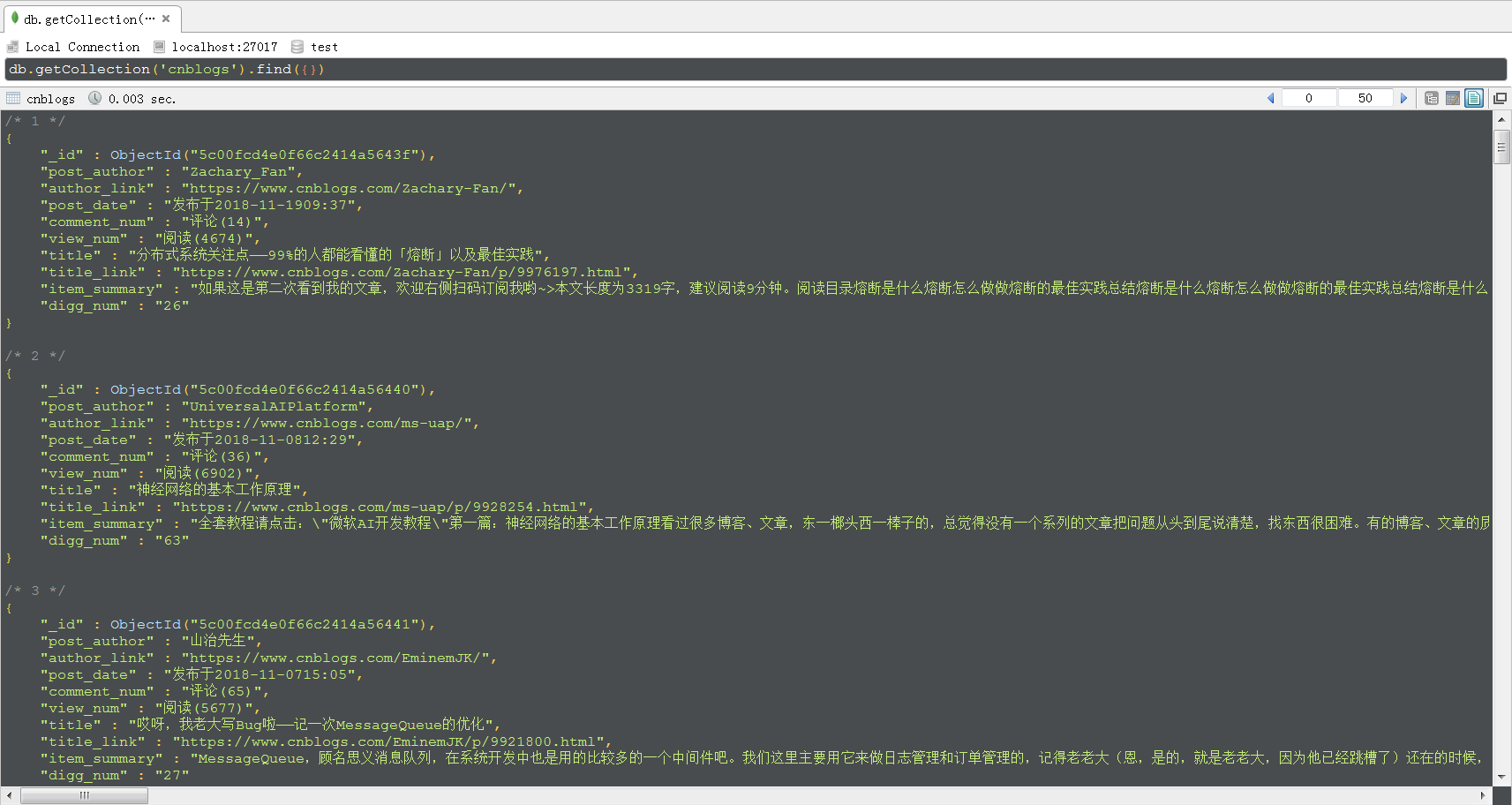程式爬取目標 獲取博客園精華區文章的 標題、標題鏈接、作者、作者博客主頁鏈接、摘要、發佈時間、評論數、閱讀數和推薦數, 並存儲到 MongoDB 中。 程式環境 已安裝scrapy 已安裝MongoDB 創建工程 在命令提示符中執行上述命令後,會建立一個名為 的文件夾。 創建爬蟲文件 執行上述命令後 ...
程式爬取目標
獲取博客園精華區文章的標題、標題鏈接、作者、作者博客主頁鏈接、摘要、發佈時間、評論數、閱讀數和推薦數,並存儲到MongoDB中。
程式環境
- 已安裝scrapy
- 已安裝MongoDB
創建工程
scrapy startproject cnblogs在命令提示符中執行上述命令後,會建立一個名為cnblogs的文件夾。
創建爬蟲文件
cd cnblogs
scrapy genspider cn cnblogs.com執行上述命令後,會在cnblogs\spiders\下新建一個名為cn.py的爬蟲文件,cnblogs.com為允許爬取的功能變數名稱。
編寫items.py文件
定義需要爬取的內容。
import scrapy
class CnblogsItem(scrapy.Item):
# define the fields for your item here like:
post_author = scrapy.Field() #發佈作者
author_link = scrapy.Field() #作者博客主頁鏈接
post_date = scrapy.Field() #發佈時間
digg_num = scrapy.Field() #推薦數
title = scrapy.Field() #標題
title_link = scrapy.Field() #標題鏈接
item_summary = scrapy.Field() #摘要
comment_num = scrapy.Field() #評論數
view_num = scrapy.Field() #閱讀數編寫爬蟲文件cn.py
import scrapy
from cnblogs.items import CnblogsItem
class CnSpider(scrapy.Spider):
name = 'cn'
allowed_domains = ['cnblogs.com']
start_urls = ['https://www.cnblogs.com/pick/']
def parse(self, response):
div_list = response.xpath("//div[@id='post_list']/div")
for div in div_list:
item = CnblogsItem()
item["post_author"] = div.xpath(".//div[@class='post_item_foot']/a/text()").extract_first()
item["author_link"] = div.xpath(".//div[@class='post_item_foot']/a/@href").extract_first()
item["post_date"] = div.xpath(".//div[@class='post_item_foot']/text()").extract()
item["comment_num"] = div.xpath(".//span[@class='article_comment']/a/text()").extract_first()
item["view_num"] = div.xpath(".//span[@class='article_view']/a/text()").extract_first()
item["title"] = div.xpath(".//h3/a/text()").extract_first()
item["title_link"] = div.xpath(".//h3/a/@href").extract_first()
item["item_summary"] = div.xpath(".//p[@class='post_item_summary']/text()").extract()
item["digg_num"] = div.xpath(".//span[@class='diggnum']/text()").extract_first()
yield item
next_url = response.xpath(".//a[text()='Next >']/@href").extract_first()
if next_url is not None:
next_url = "https://www.cnblogs.com" + next_url
yield scrapy.Request(
next_url,
callback=self.parse
)編寫pipelines.py文件
對抓取到的數據進行簡單處理,去除無效的字元串,並保存到MongoDB中。
from pymongo import MongoClient
import re
client = MongoClient()
collection = client["test"]["cnblogs"]
class CnblogsPipeline(object):
def process_item(self, item, spider):
item["post_date"] = self.process_string_list(item["post_date"])
item["comment_num"] = self.process_string(item["comment_num"])
item["item_summary"] = self.process_string_list(item["item_summary"])
print(item)
collection.insert(dict(item))
return item
def process_string(self,content_string):
if content_string is not None:
content_string = re.sub(" |\s","",content_string)
return content_string
def process_string_list(self,string_list):
if string_list is not None:
string_list = [re.sub(" |\s","",i) for i in string_list]
string_list = [i for i in string_list if len(i) > 0][0]
return string_list修改settings.py文件
添加USER_AGENT
USER_AGENT = 'Mozilla/5.0 (Windows NT 6.1; Win64; x64) AppleWebKit/537.36 (KHTML, like Gecko) Chrome/70.0.3538.102 Safari/537.36'啟用pipelines
ITEM_PIPELINES = {
'cnblogs.pipelines.CnblogsPipeline': 300,
}運行程式
執行下麵的命令,開始運行程式。
scrapy crawl cn程式運行結果
程式運行結束後,MongoDB中的數據如下圖所示,採用的可視化工具是Robo 3T。

感謝大家的閱讀,如果文中有不正確的地方,希望大家指出,我會積極地學習、改正。
再次感謝您耐心的讀完本篇文章。



